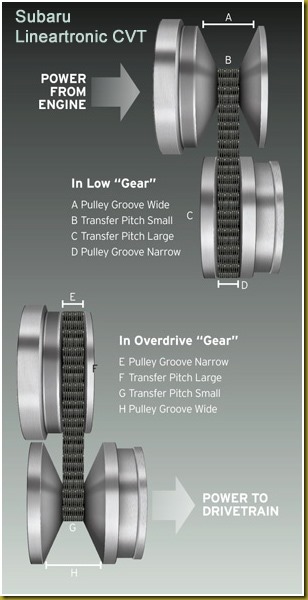Neat ticks department—Forester’s CVT transmission

One of the key points about the 2014 Subaru Forester CVT, and I assume this is true of all CVT gearbox equipped cars (but I am not sure of this), is that there is, by and large, no torque converter. Technically there actually is a modified torque converter known as a ‘start-up torque converter’ or a ‘lock-up torque converter’.
Basically this type of torque converter only acts as a torque converter during engine start and at those times when the car is stationary. At all other times the torque converter is ‘locked up’ which means it is not acting as a torque converter and the engine is engaged directly to the drive train. Just as it is with a manual gearbox fitted vehicle.
This means no loss of 6 to 8 percent of power from the engine through the torque converter when the gearbox is engaged.
Neat trick, eh?
The next ‘trick’ of the Forester’s CVT is that, because there is no torque converter power loss there is sufficient power in the drive train for the CVT to provide a second overdrive ratio instead of the typical one overdrive ratio found on ‘regular’ cars. I say ‘regular’ cars because some higher-end European vehicles, with automatic transmissions or manual transmission, have had two overdrive ratios prior to this (such as Audi).
So what, you might be saying … two overdrive ratios. Big fizz!
Well, in these days where fuel economy is getting to be a big concern this means the 2014 Gen4 Forester can slide up to this extra effective overdrive ratio to improve fuel economy on a highway run. But as one reviewer points out in his test drive the Forester will never slide up to this second overdrive ratio in metropolitan side-road driving. But get over 80 kph (50 mph) on the speedo on the highway or the freeway and the CVT drive chain slides all the way up to that magical second (or full) overdrive setting.
The third trick, and this is really the best trick of all, involves ‘Power’ mode. Now most regular automatic transmission cars have a ‘Power’ mode button hidden somewhere. What that ‘Power’ mode button does is adjust the gear-change timing decisions made by the gearbox. It doesn’t, as many people think, make the engine of the car any more powerful. It simply makes the automatic gearbox hold the lower gears a little longer when you accelerate so the engine gets up to some higher revs; and in cases where you apply the accelerator and a kick-down gear change is required then the transmission reacts to this kick-down change a second or two sooner than it would normally.
But in the 2014 Forester XT the ‘Power’ mode button, which is actually called the ‘Sport #’ (i.e., Sport Sharp) button does three things. Firstly, just like with the regular old-style automatic transmissions, it causes the CVT gearbox computer to hold ‘gears’ longer and to change down faster and sooner when the accelerator is pressed. However it also adjusts the engine’s electronic throttle mapping program to deliver quicker-than-normal throttle response. Plus, it changes the logical gear ratio selections from 6 to 8 thereby giving you six standard gears in place of the four regular gears normally available (the other two gears are the two overdrive ratios).

All this ‘magic’ going on does affect the economy, obviously, but it makes a big difference to the performance.
It can do this because of the CVT gearbox where there are no actual physical gears. The gear ratios are logical rather than physical so they can be instantly changed by the CVT management computer.
How awesome is that?
Well I thought it was awesome.
I guess about now those readers already very familiar with the functioning of CVT gearboxes are thinking to themselves something like “where has this guy been” or “who didn’t know that?”

